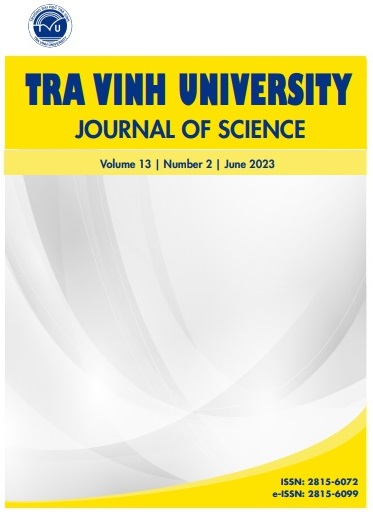FACTORS INFLUENCING THE QUALITY OF ORANGE PEEL TEA
Main Article Content
Abstract
The aim of this study was to develop the technological process of making herbal tea bags from orange peels. In order to achieve this purpose, the effects of blanching, drying conditions, and mixing ratio of orange peels,
green tea, and stevia were examined. The results showed that orange peel blanched in hot water at 80oC for 6 minutes helps to retain the green color and has high sensory value. Upon being dried at 70oC for 210 minutes, the total polyphenol content is 420.69 mg GAE/g dry weight with a final moisture content of 9%. With the mixing ratio of 70% orange peel, 25% green tea, and 5% stevia, the product has the highest sensory value-specifically color (3.84), flavors (4.07), tastes (3.61), and sweetness (3.92) -and with total polyphenols of 516.51 mgGAE/g dry matter and antioxidant activity of 119.18%.
Downloads
Article Details
References
with trypsin inhibitory activity extracted from orange
peel and green tea leaves. Journal of Science Food
Agricuture. 2013;93(6): 1420–1426.
[2] Nazir A, Itrat N, Shahid A, Mushtaq Z, Abdulrahman
SA, Egbuna, et al. Orange peel as source of nutraceuticals. In: Egbuna C, Sawicka B, Khan J. (eds.) Food
and agricultural byproducts as important source of
valuable nutraceuticals. Cham, Switzerland: Springer
International Publishing. 2022; 97–106.
[3] Tran Thanh Truc, Mai Thanh Thai, Mai Diem Trinh,
Nguyen Trong Tuan. Research on herbal tea bags
processing technology for pomelo peel of Nam Roi
cultivar (Citrus grandis (L.) Osbeck). [Nghiên cứu
công nghệ chế biến trà túi lọc từ vỏ bưởi Năm Roi
(Citrus grandis (L.) Osbeck)]. Can Tho University
Journal of Science [Tạp chí Khoa học Đại học Cần
Thơ]. 2021;57: 10–20.
[4] Nguyen Thi My Trang, Vu Ngoc Boi, Dang Xuan
Cuong. Effect of processing factors on the quality of
asparagus (Asparagus officinalis L.) tea bag. [Nghiên
cứu ảnh hưởng của một số yếu tố công nghệ đến chất
lượng của trà túi lọc măng tây]. Journal of Fisheries
Science and Technology [Tạp chí Khoa học Công
nghệ – Thuỷ sản]. 2015;2: 66–71.
[5] Nguyen Thi Hien, Nguyen Kim Phung, Nguyen Thi
Hong Tha, Nguyen Hong Phuc. The production process of mangrove tea. [Nghiên cứu quy trình sản xuất
trà túi lọc bần]. Vietnam Journal of Chemistry [Tạp chí Hóa học Việt Nam]. 2020;58(6E12): 120–125.
[6] Nguyen Kim Phung, Nguyen Thi Hien, Pham Bao
Nguyen. The production process of wood-apple tea.
[Nghiên cứu quy trình sản xuất trà trái quách].
Journal of Analytical Sciences [Tạp chí Phân tích
Hóa, Lý và Sinh học]. 2019;24: 178–182.
[7] Pham Van So, Bui Thi Nhu Thuan. Food testing.
[Kiểm nghiệm lương thực, thực phẩm]. [Lecture]
Hanoi University of Science and Technology. 1991.
[8] Kemp SE, Hollowood T, Hort J. Sensory Evaluation:
A practical handbook. UK: John Wiley & Sons. 2009;
47–139.
[9] Folin O, Ciocalteu V. On tyrosine and tryptophane
determination in proteins. The Journal of Biological
Chemistry. 1927;27: 627–650.
[10] Brand-Williams W, Cuvelier ME, Berset C. Use of a
free radical method to evaluate antio-xidant activity.
Food Science and technology. 1995;28(1): 25–30.
[11] Lin YS, Tsai YJ, Tsay JS, Lin JK. Factors Affecting
the Levels of Tea Polyphenols and Caffeine in Tea
Leaves. Journal of Agricultural and Food Chemistry.
2003;51(7): 1864–1873.
[12] Ramesh K, Singh V, Megeji NW. Cultivation of stevia
[Stevia rebaudiana (Bert.) Bertoni]: A comprehensive review. Advances in Agronomy. Academic Press.
2006;89: 137–177
[13] Deng LZ, Mujumdar AS, Zhang Q, Yang XH, Wang
J, Zheng ZAl, et al. Chemical and physical pretreatments of fruits and vegetables: Effects on drying
characteristics and quality attributes–a comprehensive
review. Critical reviews in food science and nutrition.
2019;59(9): 1408–1432.
[14] Abhay SM, Hii CL, Law CL, Suzannah S, Djaeni M.
Effect of hot-air drying temperature on the polyphenol
content and the sensory properties of cocoa beans.
International Food Research. 2016;23(4): 1479–1484.
[15] Trinh Thanh Tam, Nguyen Quoc Cuong, Tu Phan
Nam Phuong, Dong Thi Anh Dao. The effects of
drying conditions on the nutritional compositions of
black fungus Auricula-judae powder. [Nghiên cứu ảnh
hưởng của điều kiện sấy đối lưu đến thành phần dinh
dưỡng của bột nấm mèo Auricularia auricula-judae].
Journal of Science and Technology [Tạp chí Khoa học & Công nghệ]. 2011;6(A): 176–182.
